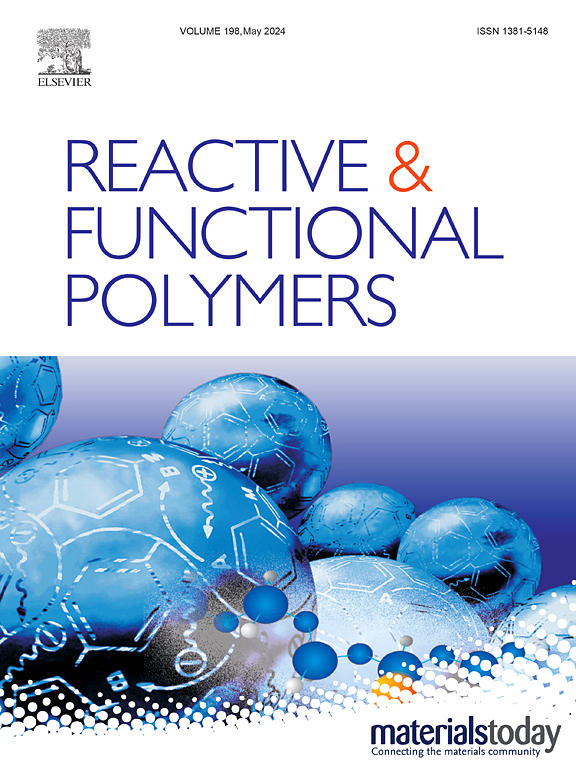Hydrogenation of poly(vinylidene fluoride-chlorotrifluoroethylene) via a visible light-initiated radical chain transfer reaction
IF 4.5
3区 工程技术
Q1 CHEMISTRY, APPLIED
引用次数: 0
Abstract
This study presents a visible-light-induced hydrogenation method for the efficient production of Poly(vinylidene fluoride-co-trifluoroethylene) (P(VDF-TrFE)), which is a ferroelectric polymer with significant potential in diverse applications. Here, the dechlorination of trichloroethylene fragments in polymers was displayed under mild reaction conditions, using trace amounts of Ir(ppy)₃ as a catalyst. Upon visible light irradiation, the Ir(III) complex is excited to the Ir(III)* state, which interacts with the trichloroethylene fragment, generating a macro-radical (P(VDF-CTFE)*) that abstracts hydrogen from a chain transfer reagent, reducing the C![]() Cl bond to a C
Cl bond to a C![]() H bond. Concurrently, the Ir(IV) species formed is reduced back to Ir(III) by triethylamine, completing the catalytic cycle. The catalyst facilitates repeated activation of the C
H bond. Concurrently, the Ir(IV) species formed is reduced back to Ir(III) by triethylamine, completing the catalytic cycle. The catalyst facilitates repeated activation of the C![]() Cl bond, ensuring efficient hydrogenation throughout the process. This approach offers a mild, cost-effective, and scalable method for producing P(VDF-TrFE), addressing the need for more efficient and sustainable reduction strategies in polymer processing.
Cl bond, ensuring efficient hydrogenation throughout the process. This approach offers a mild, cost-effective, and scalable method for producing P(VDF-TrFE), addressing the need for more efficient and sustainable reduction strategies in polymer processing.

可见光引发的自由基链转移反应对聚偏氟乙烯-三氟氯乙烯加氢的影响
本研究提出了一种可见光诱导加氢方法,用于高效生产聚偏氟乙烯-共三氟乙烯(P(VDF-TrFE)),这是一种具有广泛应用潜力的铁电聚合物。在这里,用微量的Ir(ppy)₃作为催化剂,在温和的反应条件下,展示了聚合物中三氯乙烯片段的脱氯。在可见光照射下,Ir(III)配合物被激发到Ir(III)*态,与三氯乙烯片段相互作用,产生巨自由基(P(VDF-CTFE)*),从链转移试剂中提取氢,将CCl键还原为CH键。同时,形成的Ir(IV)被三乙胺还原回Ir(III),完成催化循环。催化剂促进了CCl键的重复激活,确保了整个过程中有效的氢化。该方法为生产P(VDF-TrFE)提供了一种温和、经济、可扩展的方法,解决了聚合物加工中对更有效和可持续的还原策略的需求。
本文章由计算机程序翻译,如有差异,请以英文原文为准。
求助全文
约1分钟内获得全文
求助全文
来源期刊

Reactive & Functional Polymers
工程技术-高分子科学
CiteScore
8.90
自引率
5.90%
发文量
259
审稿时长
27 days
期刊介绍:
Reactive & Functional Polymers provides a forum to disseminate original ideas, concepts and developments in the science and technology of polymers with functional groups, which impart specific chemical reactivity or physical, chemical, structural, biological, and pharmacological functionality. The scope covers organic polymers, acting for instance as reagents, catalysts, templates, ion-exchangers, selective sorbents, chelating or antimicrobial agents, drug carriers, sensors, membranes, and hydrogels. This also includes reactive cross-linkable prepolymers and high-performance thermosetting polymers, natural or degradable polymers, conducting polymers, and porous polymers.
Original research articles must contain thorough molecular and material characterization data on synthesis of the above polymers in combination with their applications. Applications include but are not limited to catalysis, water or effluent treatment, separations and recovery, electronics and information storage, energy conversion, encapsulation, or adhesion.
 求助内容:
求助内容: 应助结果提醒方式:
应助结果提醒方式:


